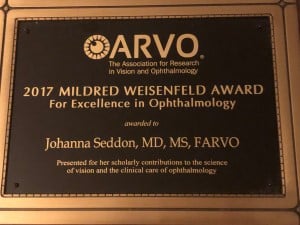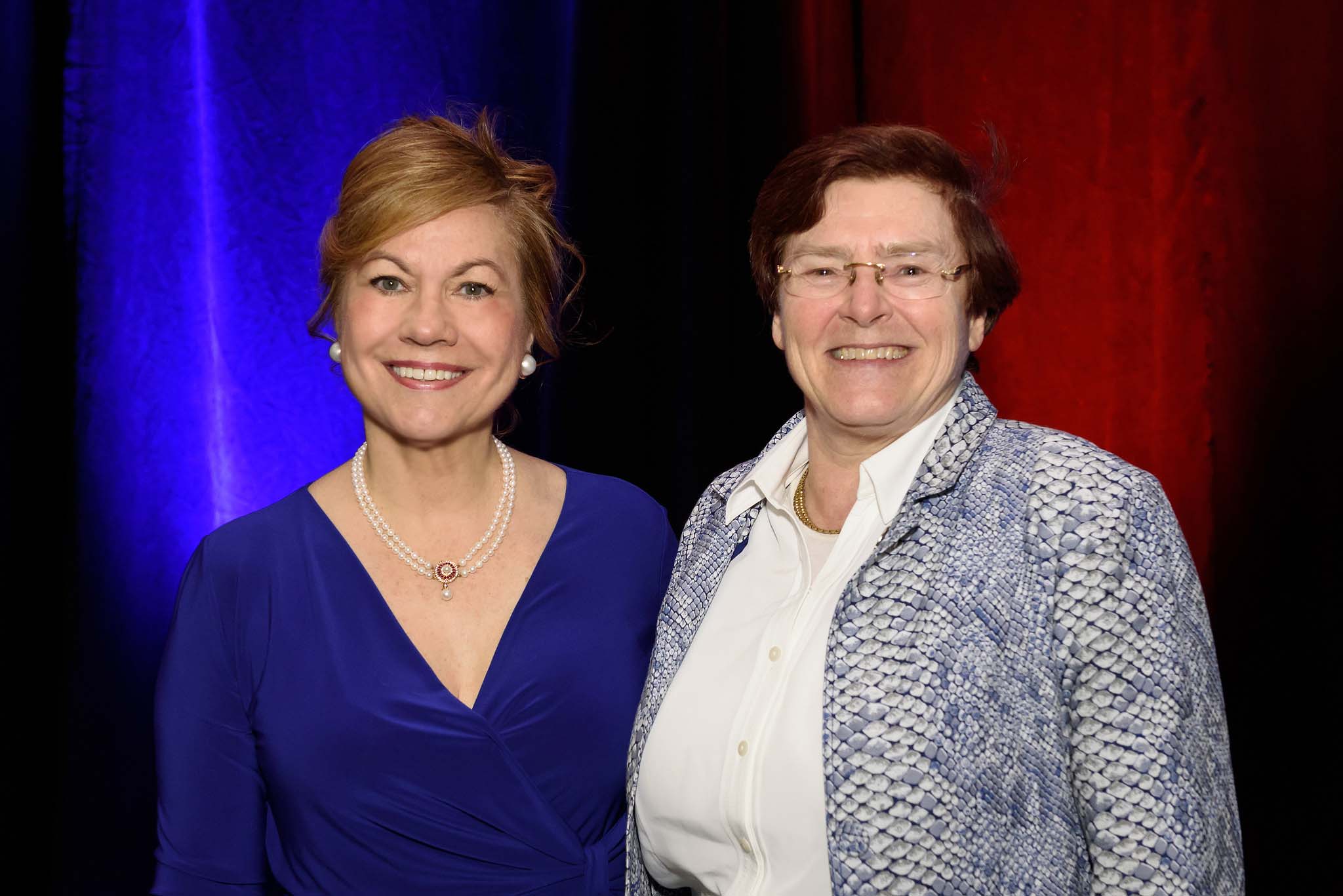Dr. Johanna Seddon Awarded 2017 ARVO Mildred Weisenfeld Award
Below is the introduction from Martine J. Jager, Department of Ophthalmology, Leiden University Medical Center, Leiden, The Netherlands, who presented the award:
The Weisenfeld Award is presented to an individual in recognition of distinguished scholarly contributions to the clinical practice of ophthalmology, and Johanna M. Seddon, ScM, MD, is the perfect recipient to be honored with this great award. Dr. Seddon is an internationally recognized ophthalmologist and clinician–scientist, who pioneered the field of epidemiology and genetic epidemiology in ophthalmology. She has been at the forefront of scientific research into the leading cause of visual loss and blindness, age-related macular degeneration (AMD), and the determinants and risk factors for this disease since the 1980s. Her work on preventive medicine and genetics has been very influential.
The impact of Dr. Seddon’s remarkable achievements can be assessed by several measures:

|
|
- Nutritional-based prevention of AMD has become standard treatment for this disease. The beneficial effect of 6 mg/day of lutein and zeaxanthin and dietary intake of dark green leafy vegetables that she reported in 1994 has been confirmed by other studies and her work helped to stimulate national clinical trials of nutritional supplements. Lutein is the most widely recommended nutrient in ocular supplements now on the market and recommended by the American Academy of Ophthalmology. Eat your dark green leafy vegetables!
You Are What You Eat! - She identified modifiable factors for onset and progression to advanced stages of macular degeneration, which have changed the management of this disease. Associations between AMD and body weight and weight distribution, as well as smoking, physical activity, and other modifiable factors like dietary fats, trans fats, and omega-3 fatty acids evolved from her studies initiated in the 1980s, at which time none of these risk and preventive factors for progression were known.
- In the 1980s, Seddon conceptualized that the common disease AMD could also have a genetic component, launched genetic epidemiologic studies, and found that AMD has a strong genetic component in her landmark population-based national twin study in the United States. She began a biorepository and led several efforts, which evolved into numerous groundbreaking discoveries about the genetic underpinnings of the disease.
- Determinants of high or low risk of progression to advanced stages of AMD and prediction models evolved from Dr. Seddon’s initial studies. Her team’s analyses were the first to demonstrate that AMD genes are related to progression of the disease, and developed the initial AMD risk prediction models combining genetic and nongenetic predictors which have direct relevance to personalized medicine.
This knowledge of nutrition, behaviors, and genetics comes from extensive research and decades of persistent, hard work of Dr. Seddon. She has forged successful multidisciplinary collaborations and continues to integrate new epidemiologic, biologic, and molecular approaches for studying mechanisms related to the high impact of rare genetic variants and differences in phenotypes and outcome for different genetically susceptible individuals.
Dr. Seddon earned an MD degree from the University Of Pittsburgh School of Medicine and completed Harvard fellowships in Ophthalmic Pathology and Vitreo-Retinal Diseases. She was the first ophthalmologist to obtain a graduate degree in Epidemiology from the Harvard School of Public Health. As a retina specialist, she specializes in the evaluation and treatment of patients with macular degenerations, macular dystrophies, and retinal vascular disorders.

Weisenfeld Award. |
|

|
When Dr. Seddon began her studies, there were no known risk factors other than advanced age, and no treatments other than possibly laser treatment. Recruited to the faculty of the Massachusetts Eye and Ear Infirmary in the early 1980s, Dr. Seddon developed and directed one of only two Epidemiology Units focused on the origins of eye diseases, prevention, and public health. She conceptualized that both genetic and nongenetic risk factors, like smoking and diet, and other lifestyle factors could be related to AMD, the leading cause of blindness. Based on her scientific background in epidemiology and knowledge of nutritional and genetic epidemiology, she launchthe first systematic study of nutrition in ophthalmology and was principal investigator of the dietary ancillary study of the Eye Disease Case-Control Study. She designed and tested a new food frequency questionnaire, the first use of such a questionnaire in a study designed to evaluate eye diseases. Discoveries resulting from this work received wide national and international recognition, including the first report of the beneficial association of higher dietary intake of lutein and zeaxanthin on risk of advanced neovascular macular degeneration. Higher intake of foods rich in these carotenoids including dark green leafy vegetables, spinach and kale, etc. reduced risk. The article was published in The Journal of the American Medical Association (JAMA) and by invitation was presented at the Science Writer’s conference in 1994. She reported at ARVO the first observation that dietary intake of omega-3 fatty acids reduced the risk of advanced disease.
She also launched the initial prospective studies designed to assess the impact of modifiable behaviors on the risk of transition from early and intermediate disease to advanced stages of macular degeneration. Her prospective study of cigarette smoking was the first to show a strong impact of this exposure on risk of progressing to the advanced forms of the disease, with as much as a third of the disease attributable to smoking. Her studies also found associations with exercise (beneficial effect) and abdominal adiposity (increased risk). Despite some professional skepticism, she launched these studies that helped lay the groundwork for the current recommendation of dietary and other healthy behaviors as part of the management of AMD.
Another significant and pioneering contribution during that same time period was her early recognition that AMD could have a genetic component. She launched genetic epidemiologic studies of macular degeneration, including the first large, population-based US Twin Eye Study to dissect genetic and nongenetic factors, reported the aggregation of the disease in families, and determined the relative contributions of both genetics and environment to various stages of AMD. She started a DNA and other sample biorepository and led multidisciplinary collaborations resulting in significant discoveries about the genetics of AMD. Numerous genetic variants influence risk, including several genes and common and rare variants discovered by Dr. Seddon and her team. Some of those important contributions include the discovery of genes in the complement pathway related to AMD: complement factor I (CFI), complement components 3 (C3) and 9 (C9), the discovery of novel variants in the gene complement factor H (CFH), as well as the discovery of new AMD genes in the lipid, angiogenesis, and collagen matrix pathways.
A particularly noteworthy contribution is her discovery of rare genetic variants with high penetrance and strong impact on the development and progression of macular degeneration. This includes the first confirmed rare variant for this disease, the variant R1210C in CFH, which to date has the highest impact of any genetic variant, raising risk of the disease up to 20-fold. She defined the earlier age of onset and typical macular phenotype with higher drusen burden and more advanced disease associated with this variant, by using her large macular degeneration registry and biorepository. With collaborators in the US and Europe, Dr. Seddon’s team identified several other rare variants in the complement pathway with stronger associations with macular degeneration compared with the common variants, including numerous rare variants in CFI and variants in C3 and C9. She was the first to report that both common and rare genetic variants can influence progression from the early or intermediate stages to the advanced forms of the disease, independent of other genetic variants. Several of these genetic susceptibility factors are now included in macular degeneration risk prediction models, which show high predictability for progressing to advanced disease of over 90%. The latest model, available online in the public domain at www.seddonamdriskscore.org, is useful for research studies, identifying high risk individuals for clinical trials, and is relevant for the emerging field of precision medicine.
.

Martine J. Jager (right). |
|
Dr. Seddon has authored over 250 scientific papers, including articles in Nature Genetics, JAMA, Proceedings of the National Academy of Sciences, in addition to numerous reviews, editorials, and book chapters, as well as a unique book focused on ocular nutrition, Eat Right for Your Sight. She has been an international and named guest lecturer in the areas of retina, nutrition, and genetics. Dr. Seddon has served on many committees and boards, including Survey of Ophthalmology Editorial Board, National Institutes of Health Study Sections, Scientific Advisory Board of Foundation Fighting Blindness, and Study Advisory Committees. She has had senior leadership positions in the Association for Research in Vision and Ophthalmology (ARVO) as an elected Trustee (1992–1997) and then Vice-President (1996–1997), has contributed to ARVO committees including Chair of the first ARVO Women’s Committee (1996) and membership in the Advocacy Committee (2012–2015), and has received the Special Recognition Award from ARVO (1998), the inaugural ARVO Gold Fellow Award, and senior achievement award from the American Academy of Ophthalmology. Her contributions to macular degeneration and epidemiology research and service to ophthalmology have been recognized by several other prestigious awards, including membership in the American Epidemiological Society, the inaugural Maurice F. Rabb, Jr. MD Award from Prevent Blindness America, the Lew R. Wasserman Award from Research to Prevent Blindness, the Philip S. Hench, MD, Award from the University of Pittsburgh School of Medicine Alumni Association, the Women in Ophthalmology science and mentorship awards, the Kreissig Award from the EuRetina Society, and the Lucien Howe Medal award. She was also honored by being named a charter member of the Retina Hall of Fame.
In summary, Dr. Seddon has made pioneering discoveries, which have advanced the fields of nutritional and genetic epidemiology in ophthalmology. She has led multidisciplinary teams resulting in seminal contributions toward understanding the etiology, prevention, and treatment of macular degeneration. Her groundbreaking work still continues, generating new information about the etiology of AMD, gene-environment interactions, accelerating and influencing the path of research by others in the field of retinal degenerations. It is indeed fitting that ARVO recognizes the importance of preventive medicine and genetics in Ophthalmology and Dr. Seddon’s outstanding contributions to these fields by awarding her the Mildred Weisenfeld award. New insights generated by her meticulous work over many years have helped millions of people worldwide by reducing the burden of visual impairment and blindness due to this disease
